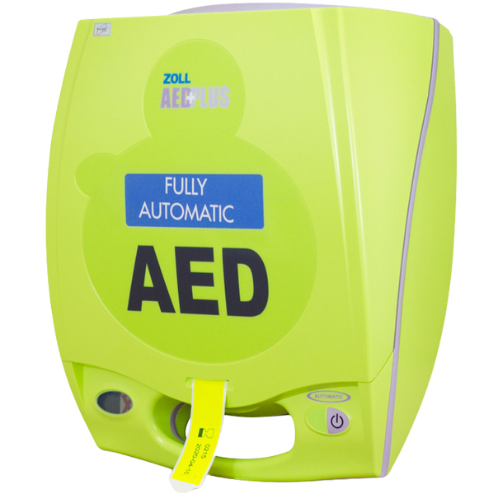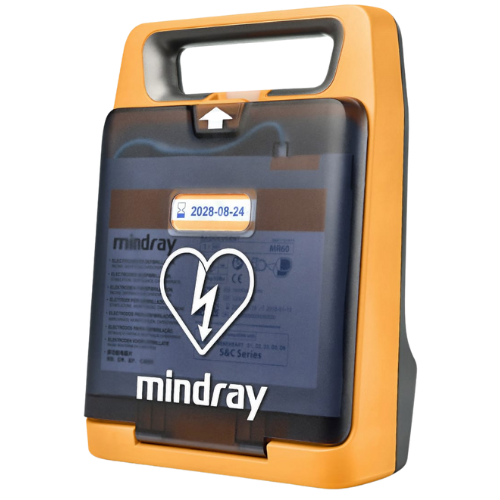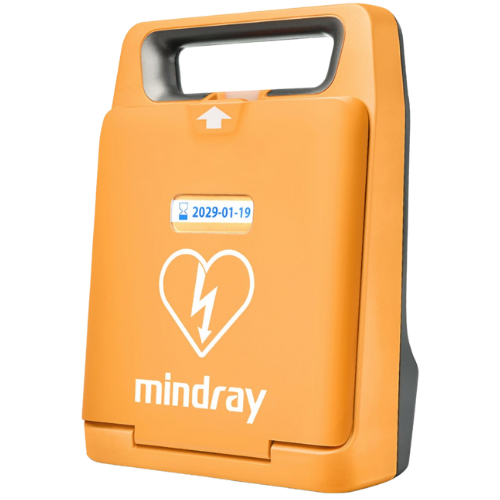Defibrillators in the Office: Where Should You Install One?
Cardiac arrest can occur anywhere, including the workplace. Each minute without defibrillation reduces a person’s chance of survival by about 10%, according to the British Heart Foundation (BHF). This makes quick access to a defibrillator, also known as an automated external defibrillator (AED), essential in office environments.
The ZOLL AED Plus is one of the most recognised models for office use in the UK. It provides clear voice and visual prompts, along with Real CPR Help feedback technology that guides users through chest compressions. These features make it particularly suitable for workplaces where employees may have little or no medical training.
Installing an AED in your office is more than a compliance measure, it is a practical step to ensure a rapid response to sudden cardiac arrest. However, owning a defibrillator is not enough; where you install it directly affects how quickly it can be reached and used in an emergency.
Did You Know?
Research cited by the Resuscitation Council UK shows that public access defibrillators are used in only about 10% of out-of-hospital cardiac arrests, often because they are not visible or easily accessible.
In many offices, defibrillators are placed behind reception desks or in staff rooms, making them harder to reach during an emergency. Visibility, access speed, and clear signage are all essential considerations, and these factors will guide the correct installation of a ZOLL AED Plus in your workplace.
Why Optimal Placement Matters
When a person experiences sudden cardiac arrest, the heart’s normal rhythm stops, and blood flow to vital organs ceases. Every second counts. According to the Resuscitation Council UK, immediate CPR and early defibrillation within three to five minutes can increase survival chances to over 50%.
This statistic underscores why placement is just as important as owning an AED. A defibrillator stored in a locked office or distant floor can be as inaccessible as not having one at all. The goal is to ensure that a responder can reach the ZOLL AED Plus and return to the patient within 60 seconds.
Common Obstacles in Office Environments
In modern office layouts, physical barriers can delay access:
Locked doors or restricted rooms can prevent quick retrieval.
Multiple floors or corridors extend travel time.
Inadequate signage can confuse staff unfamiliar with the layout.
Cluttered communal areas may hide the device from view.
The ZOLL AED Plus has a high-visibility green case and optional wall-mount brackets, which help reduce these risks. When mounted in a visible, central location, it becomes immediately recognisable, even under stress.
The 3-Minute Response Principle
Industry best practice recommends that an AED should be accessible within three minutes round trip, roughly 90 seconds each way. For larger premises or multi-floor offices, this may require more than one device.
Human Observation: In open-plan offices, defibrillators installed near shared coffee stations or print areas tend to be more visible and less likely to be blocked by furniture or displays.
Correct placement ensures that the ZOLL AED Plus can be located, retrieved, and applied swiftly, improving the likelihood of a positive outcome before emergency services arrive.
Features of the ZOLL AED Plus That Influence Placement
The ZOLL AED Plus is designed for use by lay responders in high-stress environments, such as workplaces. Its features directly affect where and how it should be installed to maximise accessibility and effectiveness.
1. Real CPR Help® Feedback Technology
The ZOLL AED Plus provides real-time feedback on compression rate and depth through both visual and audible prompts. This technology encourages correct technique and rhythm, which can double survival chances compared with CPR alone.
Because the device relies on both sound and display, it should be installed in an area with sufficient lighting and low background noise, such as a main corridor or reception area rather than a noisy server room.
2. High-Visibility Design
The AED’s bright green casing and distinctive graphics are intended to draw attention, even from a distance. To make the most of this feature:
Mount the unit at eye level using a wall bracket or cabinet.
Avoid corners, pillars, or shelving that obscure visibility.
Place clear “AED” directional signage from all main routes.
This visual accessibility is critical in emergencies when staff may not recall its exact location.
3. Environmental Durability
The ZOLL AED Plus carries an IP55 rating, meaning it is protected against limited dust ingress and low-pressure water jets from any direction. While this makes it suitable for some semi-exposed environments such as reception areas near entrances, it should not be placed outdoors unless housed in a heated, weatherproof cabinet.
In offices with variable temperatures or humidity, for example, near loading bays, a cabinet with temperature control is recommended.
4. Battery and Pad Design
The unit uses consumer lithium batteries that typically last up to five years and CPR-D Padz that combine pads and CPR sensor in a single piece. These simplify maintenance and reduce the need for frequent checks. For convenience, the AED should be located near the responsible first aid team to enable easy inspection and record-keeping.
Did You Know?
The ZOLL AED Plus uses standard Duracell 123 lithium batteries, which can be purchased from most high-street or online retailers, making maintenance easier for offices without specialist support contracts.
These features make the ZOLL AED Plus an adaptable choice for a range of office environments, provided it is installed in a visible, accessible, and stable location.
Key Principles for Office Installation
Installing a defibrillator in an office involves more than selecting a convenient wall. The aim is to ensure rapid access, clear visibility, and safe operation in any emergency. The following principles apply when positioning the ZOLL AED Plus in a workplace.
1. The 60-Second Rule
The AED should be reachable and ready for use within 60 seconds of identifying a cardiac arrest. This rule ensures that a rescuer can reach the device and return to the patient quickly enough to maintain the critical three-to-five-minute survival window.
In large offices or multi-floor premises, this may mean installing multiple AEDs. Ideally, each should serve a radius of approximately 100 metres.
2. Central and High-Footfall Areas
Select a central, frequently used location such as a main corridor, reception area, or staff kitchen. These areas are more likely to be known by everyone and are less prone to being locked or obstructed. The bright green ZOLL AED Plus housing supports visibility, especially when paired with standard AED signage above doorways and on approach routes.
3. Avoid Locked or Restricted Rooms
A common mistake is to place the defibrillator inside a first aid room, manager’s office, or cupboard that is sometimes locked. The AED must remain publicly accessible at all times. If security is a concern, a transparent wall cabinet with an audible alarm can be used instead.
4. Consider Environmental Conditions
The ZOLL AED Plus functions best between 0 °C and 50 °C. Avoid locations exposed to direct sunlight, radiators, or air vents, which may affect battery and pad life. If you need to install one near an external door or loading bay, use a temperature-regulated cabinet to maintain stability.
5. Visibility and Signage
An AED should be instantly recognisable. Mount it:
Between 1.2 m and 1.5 m from floor level.
On a contrasting background, such as a white wall behind the green case.
With ISO-standard AED signage visible from multiple angles.
Directional arrows or floor stickers can guide staff from key points, such as lifts or stairwells, directly to the AED’s location.
6. Accessibility for All Users
Ensure that the AED’s position allows access for wheelchair users and avoids narrow spaces or obstacles. The ZOLL AED Plus wall bracket allows for secure yet open installation, keeping the handle easy to reach for any user.
Human Observation: Offices that display AED signage in lifts and near reception desks often find that even new employees can locate the device without training, improving real-world readiness.
Following these principles creates a safer, more responsive environment where the ZOLL AED Plus can be deployed within seconds.
Suggested Locations in Typical Office Layouts
Choosing the right spot for your ZOLL AED Plus depends on your office’s layout, size, and daily activity flow. The aim is simple, the defibrillator must be highly visible, easy to reach, and never behind barriers. Below are the most effective and commonly recommended locations across different types of workplaces.
1. Reception or Lobby Area
The reception is often the most visible and accessible part of an office. It’s the first area people see when entering and is usually staffed during working hours. Installing a ZOLL AED Plus here ensures that employees, visitors, and emergency responders can locate it immediately.
Mount it on a wall close to the main entrance.
Add clear signage visible from both directions of approach.
Keep the area clear of furniture or promotional stands.
2. Main Corridors and Central Walkways
Long corridors or open-plan pathways make ideal routes for access. These areas connect different sections of the building, allowing responders from multiple departments to reach the AED quickly.
Install midway along a central corridor or near a lift lobby.
Ensure the device is visible from either end of the hallway.
3. Break Rooms or Kitchen Areas
Communal areas like staff kitchens or coffee stations are familiar to everyone and typically see high daily use. Mounting the AED here increases awareness and encourages employees to notice and remember its location.
Avoid direct exposure to heat or moisture (e.g., near kettles or ovens).
Use wall brackets to keep the AED above countertop level.
4. Near Meeting or Training Rooms
Large meeting rooms, lecture spaces, and training areas often accommodate many people at once. The likelihood of needing an AED in these spaces is statistically higher due to the number of occupants.
Position the ZOLL AED Plus just outside the main doors.
Label it on the room’s floor plan or emergency information sheet.
5. Stairwell Landings or Lift Lobbies
For multi-storey buildings, each floor should ideally have its own AED. Stairwell landings or lift lobbies serve as neutral, easy-to-find zones connecting all users.
Place the AED on a wall beside the lift or stair entrance.
Avoid corners that restrict visibility or access.
6. Warehouse, Workshop, or Loading Areas
If your office connects to an industrial or storage area, consider a second ZOLL AED Plus near the transition point between the office and operational space.
Use a weather-resistant cabinet if temperatures vary.
Ensure it is not obstructed by stock, machinery, or equipment.
Did You Know?
The Health and Safety Executive (HSE) recommends assessing both footfall and response time when determining AED placement. A location may seem convenient but could still exceed the three-minute access guideline if staircases or security gates are involved.
Strategic placement of the ZOLL AED Plus ensures staff can locate and retrieve the device rapidly, even under pressure.
Signage, Wayfinding & Accessibility
Even the best-positioned AED can be missed in an emergency if it is not clearly marked. Clear, consistent signage helps ensure that anyone, not just trained first aiders, can locate the ZOLL AED Plus quickly when every second counts.
1. Use Standardised AED Signage
In the UK, defibrillator signage should follow the ISO 7010 standard, which uses a green and white heart symbol with a lightning bolt and a cross. This design is universally recognised and should be visible from multiple angles.
Place signage:
Directly above the wall cabinet or bracket.
On approach routes, such as corridors, lift lobbies, and stairwell entrances.
At eye level, ensuring it’s not hidden by noticeboards or partitions.
If your office uses a branded or decorative style, avoid altering the AED symbol, consistency improves recognition during emergencies.
2. Directional Wayfinding
Install directional arrows or floor stickers leading to the defibrillator from key areas such as entrances, canteens, or meeting rooms. These small visual cues can make a significant difference in large or multi-floor buildings.
For example:
Place stickers in lift lobbies stating “AED on Floor 2 – Opposite Reception”.
Add wall arrows at corridor junctions pointing towards the AED.
3. Visibility Under Different Lighting
Ensure that the ZOLL AED Plus remains visible even in low-light or power-outage situations. The AED’s bright green case enhances visibility, but consider:
Supplementary emergency lighting in corridors.
Photoluminescent (glow-in-the-dark) signage near the AED.
Avoiding glass doors or reflective surfaces that obscure signage.
4. Accessibility for All Users
Placement must comply with Equality Act 2010 principles. The defibrillator should be usable by any member of staff or visitor, including wheelchair users. To achieve this:
Mount the AED between 1.2 m and 1.5 m above ground.
Keep at least 1 m of clear floor space in front of it.
Avoid steps or uneven flooring.
The ZOLL wall bracket and semi-recessed cabinet options make it easy to maintain accessibility while keeping the device secure and visible.
Human Observation: Offices that include AED signage on emergency evacuation maps often notice faster recall among staff during drills, a simple, low-cost improvement with a big impact.
Clear signage and accessible installation mean that anyone, even under stress, can locate and use the ZOLL AED Plus without delay.
Maintenance, Checks & Registration
Once your ZOLL AED Plus is installed, maintaining it correctly is vital to ensure it remains operational in an emergency. AEDs require minimal upkeep, but regular checks and registration with emergency services ensure reliability and visibility when needed most.
1. Routine Visual Checks
Assign responsibility for routine inspection to a named first aider or facilities team member. Checks should be completed at least once a month, or more frequently in busy environments.
Each inspection should confirm:
The status indicator shows the green tick (meaning ready for use).
The CPR-D Padz are in date and sealed.
The batteries have not expired or been tampered with.
The device and cabinet are clean, visible, and unobstructed.
ZOLL’s status indicator window makes it easy to verify readiness at a glance, if it shows a red X, action is required immediately.
2. Recording and Auditing
Maintain a simple AED inspection log. This may be a paper checklist mounted near the cabinet or a digital logbook. Include:
Inspection date
Inspector name or initials
Battery and pad expiry dates
Any issues identified and actions taken
Keeping accurate records supports compliance with workplace health and safety audits and demonstrates due diligence.
3. Replacing Pads and Batteries
The ZOLL CPR-D Padz typically last up to five years, and the Duracell lithium batteries have a similar lifespan under normal conditions.
When replacement is required:
Use only genuine ZOLL parts to maintain warranty and reliability.
Store spare pads and batteries in a cool, dry location, away from direct sunlight.
Record installation dates for easy tracking.
4. Registering Your AED
In the UK, every defibrillator should be registered with “The Circuit”, the National Defibrillator Network, managed by the British Heart Foundation in partnership with the NHS, ambulance services, and the Resuscitation Council UK.
Registration ensures:
999 call handlers can direct emergency responders to your AED.
You receive notifications for pad and battery expiry.
Data on public access AEDs remains accurate and up to date.
You can register your AED here: https://www.thecircuit.uk/
Did You Know?
Once registered, local ambulance control rooms can view your AED’s status and direct callers to it during an emergency, even if your office is closed.
5. Annual Service or Review
Although the ZOLL AED Plus requires no internal calibration, schedule an annual review to confirm:
All accessories are in place.
Signage remains visible and compliant.
Staff are reminded of the AED’s location and function.
An annual refresher session or inclusion in first aid training ensures that everyone feels confident using the device if needed.
Human Observation: Offices that include AED checks in their monthly fire alarm routine rarely overlook inspections, combining both tasks improves consistency and accountability.
Maintaining your AED properly ensures that your investment in the ZOLL AED Plus translates into true readiness and reliability.
Case Study / Example Layout
To illustrate effective placement, let’s consider a medium-sized UK office, a two-floor administrative building with approximately 80 employees. The workplace includes a reception area, several meeting rooms, open-plan workspaces, and a small warehouse to the rear. The company has chosen the ZOLL AED Plus as its standard defibrillator.
1. Office Overview
Ground Floor: Reception, meeting rooms, kitchen, and warehouse access.
First Floor: Open-plan workspace, smaller meeting areas, and restrooms.
Emergency exits: Two stairwells and a lift connecting the floors.
The goal is to achieve AED access within 60 seconds from any part of the building.
2. Recommended AED Locations
Reception Area (Ground Floor)
The primary ZOLL AED Plus is mounted near the main entrance.
Positioned beside the fire alarm panel for high visibility.
Visible from the entrance and marked with ISO 7010 signage.
Accessible to visitors and staff alike.
First-Floor Lift Lobby
A second AED is placed opposite the lift, mounted on a ZOLL wall bracket.
The area is central to all departments and avoids locked corridors.
Directional arrows guide staff from both wings of the floor.
Warehouse Entrance (Secondary Location)
Due to the industrial nature of the rear area, a weather-protected cabinet is used.
Staff working with equipment or vehicles can access the AED without re-entering the main office.
This configuration ensures that no employee is more than a 90-second walk from an AED in any direction.
3. Response Flow Example
When an employee collapses in a first-floor meeting room:
A colleague calls 999 and starts CPR.
Another runs to the lift lobby, retrieves the ZOLL AED Plus, and returns within 40 seconds.
The device provides real-time CPR feedback and guides the rescuer through each step.
Ambulance control, via The Circuit, confirms that an AED is on site and dispatches support.
This simple layout and training scenario demonstrate how strategic positioning allows quick, confident response, the key factor in survival.
Did You Know?
Research published in the British Medical Journal found that workplaces with AEDs placed within three minutes’ reach had twice the survival rate compared to those with limited access, even without professional responders present.
Human Observation: Offices that map their AEDs on the staff intranet and display a floorplan near each lift find that awareness increases dramatically, even among new starters and visitors.
The case study highlights how thoughtful placement of the ZOLL AED Plus can make a meaningful difference in emergency readiness without disrupting normal office design.
Frequently Asked Questions (FAQ)
1. Do I need more than one AED in my office?
It depends on the size, layout, and occupancy of your workplace. A good rule of thumb is that an AED should be reachable within 90 seconds from anywhere in the building. Multi-floor offices, or those with locked access points, will often need more than one device. The ZOLL AED Plus’s portability and wall-mount options make it easy to deploy across multiple areas if required.
2. Can anyone use the ZOLL AED Plus?
Yes. The device is designed for untrained users and provides clear voice and visual instructions. Its Real CPR Help® technology gives live feedback on compression depth and rate, ensuring effective CPR. While formal training is encouraged, it is not required to use the AED in an emergency.
3. Where should the defibrillator not be installed?
Avoid areas that are:
Locked or restricted (e.g. first aid rooms or manager offices).
Exposed to heat, moisture, or vibration, such as kitchens or near machinery.
Obstructed or hidden behind doors or display units.
The ZOLL AED Plus is IP55 rated, meaning it can tolerate dust and splashes, but indoor or cabinet-protected mounting is recommended for offices.
4. How do I maintain the device?
Perform monthly checks to confirm the status indicator shows a green tick and all components are intact. Record pad and battery expiry dates. Replace CPR-D Padz and batteries roughly every five years or after use. Always use genuine ZOLL parts to maintain compliance and reliability.
5. What about paediatric use?
The ZOLL AED Plus can treat children under 8 years old or under 25 kg when used with paediatric pads (sold separately). These pads adjust the energy level automatically for a safe, age-appropriate shock.
6. Who should be responsible for the AED?
Assign responsibility to a trained first aider or facilities manager. They should manage monthly checks, registration on The Circuit, and ensure signage and access remain compliant. Clear accountability ensures the AED is always ready to use.
7. Should I inform emergency services about my AED?
Yes. Registration with The Circuit (thecircuit.uk) ensures your AED is visible to ambulance control rooms, allowing 999 operators to direct callers to it in an emergency, even outside office hours.
8. What if my office moves or undergoes renovation?
Relocate the AED to maintain the three-minute response rule. Update The Circuit with your new address and adjust signage promptly. The ZOLL wall bracket and cabinet options make relocation straightforward.
Human Observation: Offices that include AED awareness in their staff onboarding process find that even non-first-aid-trained employees respond faster and more confidently in emergencies.
Conclusion & Call to Action
Installing a defibrillator in your workplace is one of the simplest and most effective ways to improve emergency preparedness. Yet its value depends on where it is placed and how well it is maintained. The ZOLL AED Plus combines accessibility, durability, and intelligent feedback features that make it particularly suitable for modern office environments.
When positioned according to the 60-second access rule, supported by clear signage and regular maintenance, it can be the difference between life and death. Placement in central, visible, and unrestricted areas such as receptions, main corridors, or lift lobbies ensures that anyone can reach it quickly in a cardiac emergency.
Registering your AED on The Circuit connects it to the UK’s emergency network, allowing ambulance control rooms to guide callers directly to your device, a crucial step often overlooked by employers.
Did You Know?
The British Heart Foundation estimates that around 28,000 people in the UK experience out-of-hospital cardiac arrest each year, but fewer than 1 in 10 survive. Early defibrillation can double or triple survival chances.
Human Observation: In offices where AEDs are installed near high-traffic areas like kitchens or receptions, staff quickly become familiar with their location, making real-world emergency responses faster and more confident.
By investing in a ZOLL AED Plus, installing it in the right place, and maintaining it properly, your office will be equipped not only with a reliable medical device but also with a culture of readiness and care that can save lives.
Sources
British Heart Foundation (BHF) – Statistics on cardiac arrest survival rates and defibrillator guidance
https://www.bhf.org.ukResuscitation Council UK – Guidelines for defibrillator placement and response times
https://www.resus.org.ukHealth and Safety Executive (HSE) – Advice on first aid and workplace AED considerations
https://www.hse.gov.uk/firstaid/defibrillators.htmZOLL Medical Corporation – Product specifications and Real CPR Help technology overview
https://www.zoll.com/en/Products/Emergency-Care/AEDs/AED-PlusThe Circuit – National Defibrillator Network – UK AED registration and emergency linkage information
https://www.thecircuit.ukDefibshop UK – ZOLL AED Plus product details, IP rating, and accessories
https://www.defibshop.co.uk/zoll-semi-office-package-1








